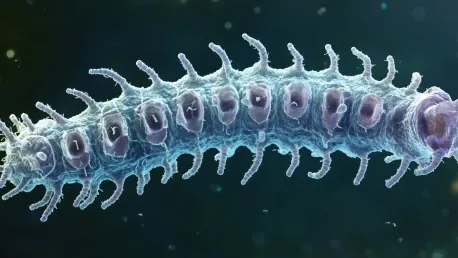The discovery of a nematode, known as Panagrolaimus kolymaensis, unearthed from the depths of the Siberian permafrost has astonished scientists. This microscopic worm managed to survive in a state of cryptobiosis for an astounding 46,000 years. Over this period, it remained suspended in a near-death state, with its metabolic processes reduced to virtually undetectable levels. Upon its recent revival in a laboratory setting, the nematode not only resumed normal biological functions but also began reproducing, providing significant insights into extremes of life and resilience.
Exploring Survival Mechanisms
Cryptobiosis: Nature’s Ultimate Survival Trick
Astonishingly, cryptobiosis is one of nature’s most remarkable survival mechanisms, intriguing scientists for its ability to suspend life processes almost indefinitely. The Panagrolaimus kolymaensis utilized this biological process to withstand millennial freezing temperatures and lack of water. Cryptobiosis, derived from the Greek words ‘crypto’ (hidden) and ‘biosis’ (living), allows an organism to enter a reversible suspension of metabolic activity when faced with adverse conditions. It achieves this state by losing almost all of its body water, thereby halting chemical reactions that could cause cellular damage.
Upon thawing, the nematode’s metabolic functions resumed seamlessly, a testament to its robust biological architecture. This state of deep dormancy enabled the nematode to endure environmental stresses that would typically be fatal. The mechanism could offer invaluable insights into developing advanced cryopreservation techniques for human organs and tissues, preserving their functionality for medical use. Investigating the genetic and biochemical pathways supporting cryptobiosis in nematodes might pave the way for new breakthroughs in preserving human life under extreme conditions, both on Earth and potentially during long-term space travel.
Cellular Protection through Trehalose
One key to the nematode’s survival lies in its production of trehalose, a sugar that serves primarily as a protective shield against cellular damage. Trehalose prevents ice crystals from forming within cells, which would otherwise puncture membranes and cause irreparable harm. The molecular structure of trehalose enables it to stabilize proteins and cell membranes during the freezing and thawing process, ensuring that the nematode’s cellular integrity is maintained under extreme conditions. This remarkable adaptation holds substantial promise for various scientific applications.
The potential to harness trehalose for human benefit is immense. Cryopreservation of human organs, crucial for transplant surgeries, often faces hurdles related to ice crystal formation. Replicating the nematode’s trehalose-based strategy could lead to more effective preservation techniques. Furthermore, applications in the food industry could see improved methods for enhancing dehydration resistance, improving shelf-life, and quality of stored food products. With ongoing research, trehalose might unlock new methods to prolong the viability of biological samples during storage and transport, emphasizing its wider implications beyond the world of microbiology and extending into various technological and industrial fields.
Implications for Future Research
Parthenogenesis and Genetic Resilience
Panagrolaimus kolymaensis exhibits an intriguing biological trait known as parthenogenesis, enabling it to reproduce without requiring a male. This form of asexual reproduction ensures the species’ survival even in conditions where finding a mate is improbable. In addition, the nematode is triploid, containing three copies of each chromosome instead of the usual two. This genetic anomaly may contribute significantly to its extraordinary resilience. The presence of multiple chromosome copies could provide the genetic redundancy required to survive various environmental challenges over millennia.
This characteristic sheds light on the adaptability of life forms to extreme situations and extends our understanding of biological limits. Studying the genetic make-up and reproductive strategies of Panagrolaimus kolymaensis can reveal new pathways and methods for enhancing the resilience of other organisms, including crops, aiding in securing food supplies under adverse climatic conditions. This knowledge could also play a crucial role in developing synthetic biology applications aimed at creating highly resilient biomaterials for various industrial applications, fostering innovation in science and technology.
Possibilities in Space Exploration
The survival of Panagrolaimus kolymaensis in the frozen depths for such an extended period broadens our understanding of life’s potential resilience. This finding has profound implications for astrobiology, the study of potential life beyond Earth. The ability of an organism to survive in cryptobiosis for tens of thousands of years suggests that life might persist in similarly extreme conditions on other planets or moons within our solar system. Researchers are keen to apply the knowledge gained from the nematode’s survival tactics to future space missions.
The study of these extremophiles could inform the design of life-detection missions to icy moons, like Europa or Enceladus, which are believed to harbor subsurface oceans. If life exists on other planets, it may well resemble these microscopic, highly resilient organisms. Moreover, understanding how extremophiles adapt and survive in such severe conditions can help in developing life-support systems for long-duration human spaceflights, enabling astronauts to endure the hostile environments of space. This breakthrough encourages scientists to contemplate broader possibilities about life’s existence and adaptability beyond our planet, offering new horizons for space exploration.
Future Considerations
Expanding Horizons in Science and Medicine
The discovery of Panagrolaimus kolymaensis has significantly expanded our comprehension of life’s resilience. Its ability to survive in cryptobiosis for thousands of years opens new avenues for scientific exploration and practical applications in biomedicine and industrial preservation. Researchers are just beginning to uncover the multitude of genetic and biochemical tools this organism employs to withstand frozen dormancy. The insights gleaned from further studies may lead to pioneering advancements in cryopreservation of human organs and tissues, leading to breakthroughs in transplant surgery and long-term storage of biological samples.
Beyond medical applications, these findings can permeate various technological and industrial sectors. For instance, insights gained from trehalose synthesis and application could revolutionize food preservation techniques, reducing waste and ensuring nutrition retention. Synthetic biology may benefit from mimicking and harnessing the resilience mechanisms seen in Panagrolaimus kolymaensis, creating robust biomaterials for use in diverse environments. The robust adaptability of this nematode illustrates that life is capable of thriving far beyond conventional boundaries, signaling untapped potential in the natural world.
Unlocking New Frontiers
Scientists have been astonished by the discovery of a nematode called Panagrolaimus kolymaensis, unearthed from the Siberian permafrost. What makes this microscopic worm remarkable is its survival in a cryptobiotic state for an incredible 46,000 years. During this time, it remained in a near-death state with its metabolic processes barely detectable. Recently revived in a lab, the nematode not only returned to normal biological functions but also began reproducing. This extraordinary survival and subsequent revival provide important insights into the extremes of life and resilience, demonstrating how some organisms are capable of withstanding and thriving after long periods of dormancy. The nematode’s ability to endure such extreme conditions offers potential applications in various scientific fields, including biology, astrobiology, and the study of life’s adaptability. This discovery encourages further exploration into other organisms that might possess similar survival strategies, shedding light on what life can endure.









